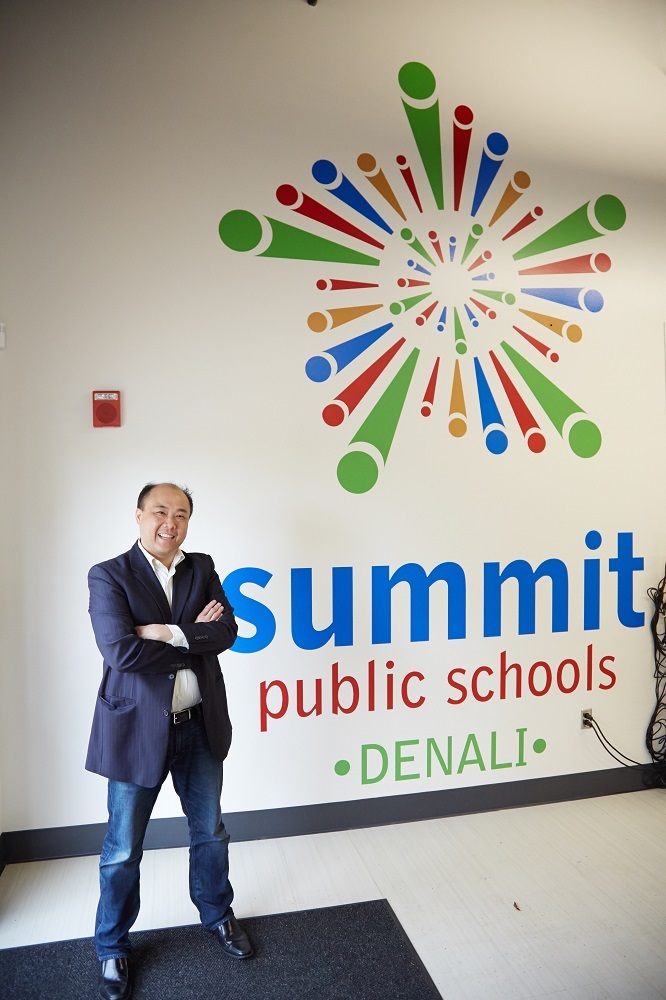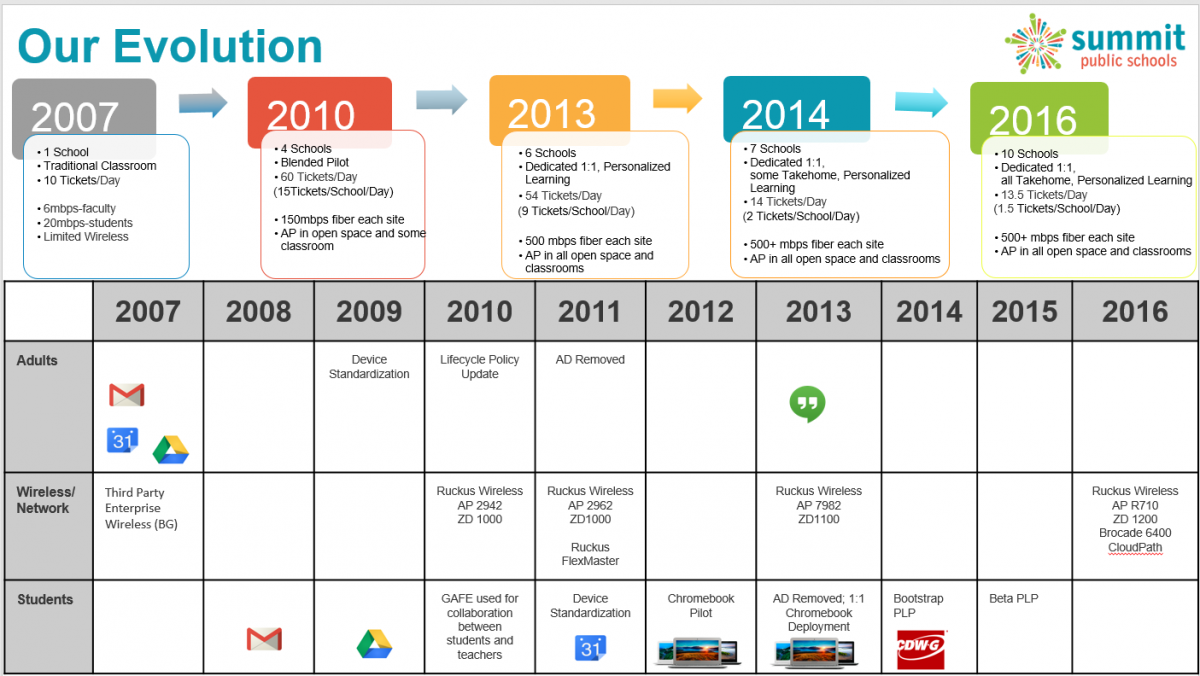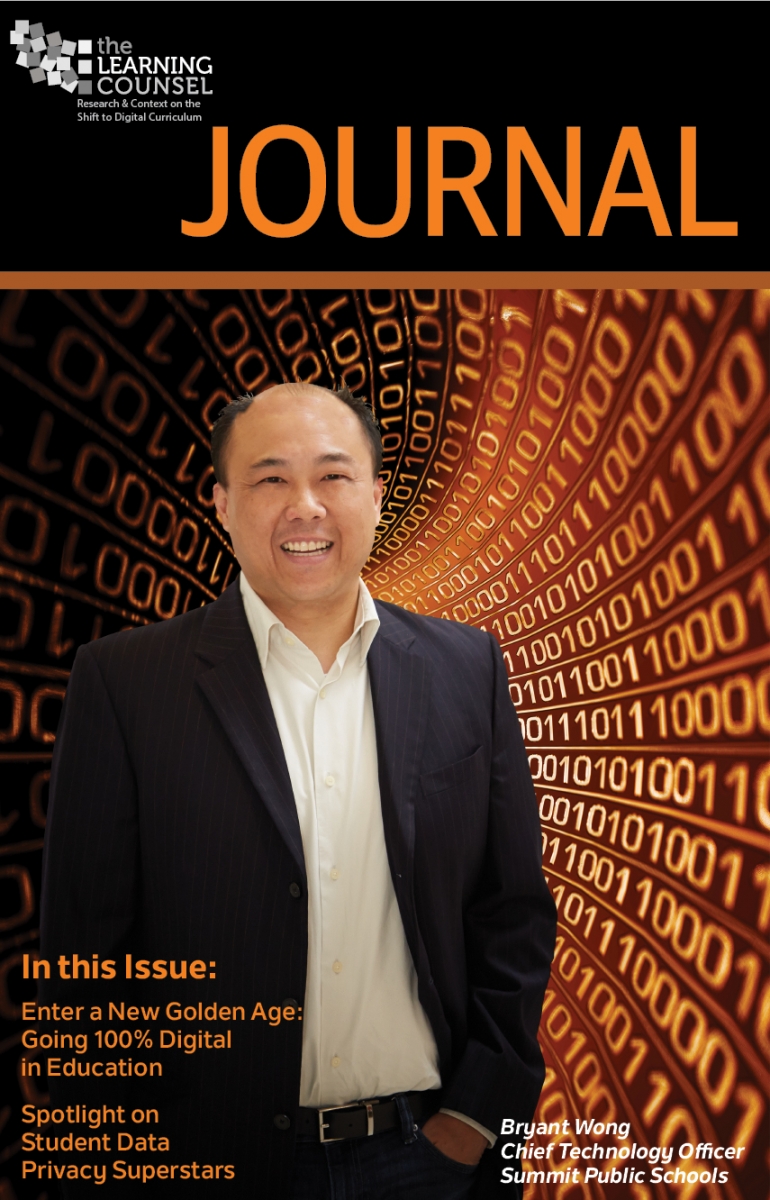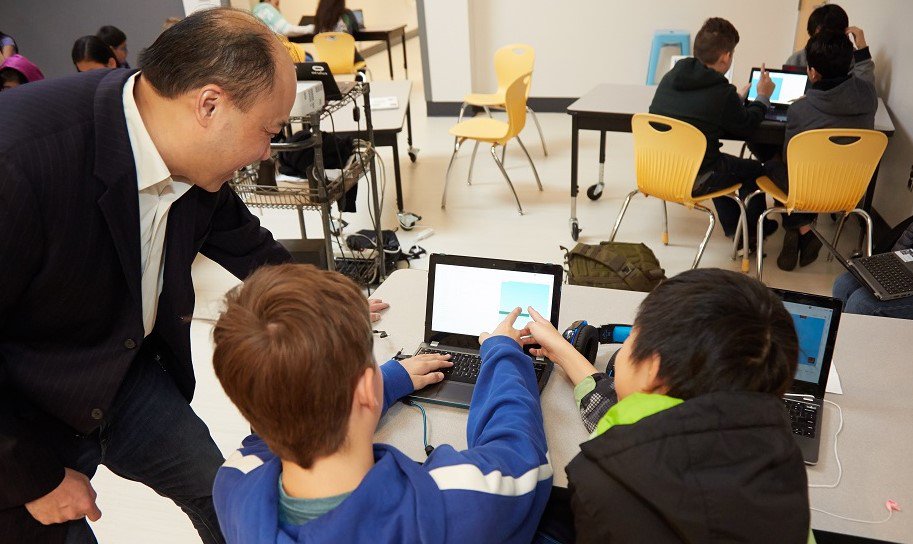Almost universally across America, school and district leaders are faceplanting into several technology challenges, including how to remap curriculum into predominately digital delivery while weaning teachers off their paper dependencies. They feel the pressure as parent’s expectations extend to assume students will be continuously engaged through personalized learning. However, most district and school leaders are not trained technologists. They often do not get the time and space to review the nuances of where this digital transformation is headed.
The teacher-to-student dynamic is fundamentally different once imbued with technology. As districts turn into seamless, technologically administered institutions, they can catch every student precisely at their point of need. But as sophisticated software that provides engaging learning experiences is introduced to students, it shifts many administrative roles for teachers and leaders. Because of this, education leaders are quickly becoming responsible for managing the entire education process via meaningful digital systems.
This realization generally comes to school leaders at 90 mph with no prospect of slowing down. One moment, students are all reading from text books and filling i n paper worksheets. The next moment, 60 students are streaming video for an in-class assignment, while at the same time, causing the other 90 students in the building, who are trying to take a test, to not be able to log on to the network, making all the students and teachers unhappy. How do leaders handle this new normalcy, which includes technology management at a different level.
n paper worksheets. The next moment, 60 students are streaming video for an in-class assignment, while at the same time, causing the other 90 students in the building, who are trying to take a test, to not be able to log on to the network, making all the students and teachers unhappy. How do leaders handle this new normalcy, which includes technology management at a different level.
A National Perspective
To cite the 2016 CoSN IT Leadership Survey, nearly ninety percent of IT Leaders expect their instructional materials to be at least fifty percent digital within the next three years. If the existing legacy infrastructure is still in place by that time, network availability and reliability issues are likely. Further, the State Education Technology Directors Association (SETDA) advises that medium sized school districts, with approximately 3,000 students, should have at least 1 gigabit per second (Gbps) per 1,000 users today, and triple that by 2020. The recent Learning Counsel National Digital Curriculum Strategy Survey of 708 education leaders, found that 80% of schools have network coverage, but that it’s inadequate for burgeoning use of digital curriculum.
There are many questions schools will need to answer as they transition to digital teaching and learning. The recommended starting place is with the underlying infrastructure, and therefore, one of the first questions is: “How is a school’s or district’s broadband and network scaling going to change to meet these new demands?” To find an answer, the Learning Counsel reached out to Summit Public Schools to speak with Bryant Wong, Chief Technology Officer. Summit is a Charter management organization with 10 schools spanning two regions in California and Washington State. They have a total student body of 3,100 between all campuses, serving kids in 6th through 12th grades. Their personalized design and technology oriented approach to teaching and learning has brought them national recognition. They additionally offer support to public schools across the country who are interested in implementing personalized learning in their classrooms. The Summit Learning Program gives schools access to Summit’s learning platform, a comprehensive curriculum, in-person professional development and ongoing support.
In this interview, Mr. Wong shares insight into Summit Public Schools' network and device implementation, digital safety programs, and how these have expanded their Wi-Fi coverage and improved academic outcomes.
Are all the Summit Public Schools 1:1, BYOD, or both? What’s your technology plan?
This has been an evolutionary process. I’ve been with Summit nine-and-a-half years now, and when I joined in 2007 we were one school, we had traditional classrooms, we had mobile carts, and we had computer labs. Over time we’ve evolved into what education calls “personalized learning.” We have ten schools dedicated to 1:1 (one device for one student). Every single student gets a Chromebook and they take it home.
Our model has grown from where we were light on the tech side, to where now we’ve got a strategy and we are more intentional about the changes we implement to create a stable infrastructure. We’re aligned, not just about bringing in technology, but we’re aligned philosophically, aligned to the outcome. That is, of course, the key from an administrative level—your tactics must be 100% aligned to a set strategic model. In our case, that is based on making sure students are successful in achieving their goals.
Can you tell us about your personal evolution as CTO at Summit?
First let me again say that it was an evolution. When I arrived, I was fortunate to have had eight years of high-tech industry experience under my belt. I think that is important for education leaders to understand. Because when I walked into education, it was a completely different beast. I had the skills for my job, but realized I had to completely rethink how to apply them in a new setting.
To orient myself, and understand the needs of our students and teachers, I immersed myself in classrooms for the first three years. While still being the CTO and running tech, I taught technology on top of it.
Those first three years were the hardest of my life, but I got to understand the challenges of classroom instruction: differentiating instruction, creating curriculum, creating projects and classroom management. These are the things that a classroom teacher faces. It helped shape my idea of how technology should work. It’s easy to say “tell me the requirements, tell me your needs” but experiencing it gives you a unique perspective. After that I knew how to make a successful technology transformation in Summit and in the classrooms that would align to academic outcomes and align to the needs of teachers.
I know that every technology leader isn’t able to jump into the classroom, and I don’t expect them to, but this does give a perspective of the mindset that will make this transformation work.
Can you tell us a little about your infrastructure and how you’re set up network-wise, to give us a sense of what’s enabling the whole transition?
Somewhere around 2010 we started exploring what personalized learning and 1:1 could look like. I knew, from my personal experience, that teachers might push tech to its maximum, or they may only use a sliver of it.
Ultimately technology was a tool that could enable and accelerate learning. It had to meet teachers in their “teaching stream”, enable what they were already doing, and help them evolve. A good example of a learning moment for me and the team was when one teacher decided to have 200 kids watch a 20 minute YouTube video together on their devices. Back then we were using wireless with low capacity. Our bandwidth back then was 45 megabits per second (Mbps). It was very eye opening to see that and to see it all fall apart. Since then we’ve pushed our bandwidth up to 500 Mbps per school.
Failures are a good thing to learn from. I specifically learned that network assumptions work well, until they are pushed to an extreme new level. Our students are adapting and becoming more tech savvy, so how do I design something for all students to be online at the same time, streaming multi-media content?
Today our networks are built to push the limits of technology, and for teachers, they have full use of the technology in a way that enables and promotes student learning.
How is Summit opening the network floodgates for learning?
Around 2013 we really got it down to a good formula. We removed all of the bandwidth restrictions, less restrictive content filtering policies, and allowed our students to make choices so they could self-direct. Students are empowered to make decisions on how they spend their time. Students not only had their academic paths opened, but they had a bunch of other multi-media paths opened—paths that supported what they wanted. What’s really interesting about the way today’s students learn is that they will have their email, platform tools, and a range of multi-media content going, all at the same time. At times, they’ll also have music and videos playing with multiple streams across multiple devices. What we have seen is that students without barriers and restrictions will own their learning and run with it.
What was the data that led to your hardware and network build out?
We had great information about how much bandwidth was being used, what our ratio for device per access point was, how many students were on and what type of online content was being consumed.
They’re not pushing static websites anymore, they’re pushing multi-media content and, lots of the time, it’s in HD. If you ask, students are willing to share their opinions. They will tell you, “this doesn’t work, that doesn’t work, this is slow, we can’t learn.” What we’ve done is clear up all the excuses—now students can’t blame the tech for not working. We cleared all the hurdles out of the way.
When you do this you also need to consider that sometimes it’s not all going to be handled internally. You need good strategy partners. There are great network companies working within education that understand the hurdles and barriers we’re facing.
Can you provide some advice to a CTO or Tech Director making this shift who isn’t there yet? Who isn’t where Summit is, but is working to get there?
The first thing, and I’ve said it before, is getting all shareholders talking the same language. This is really before anyone talks about the actual technology. I call it the chicken and duck problem. You’ll hear the Ed Services side talking chicken and the technology team talking duck. The biggest mindset shift needs to happen on the technology side, not with Ed Services. Technology must make the leap to understand the needs of the educators and be able to shape the tech to support and accelerate education.
We’re all on the same path, trying to get to the same place, the problem is; someone needs to make the translation.
Right now, outside of our network at Summit, I normally see conversations around security, network viability, network availability, all that stuff. But there’s little said that addresses academic outcomes. When the conversation comes around to academic outcomes and how tech enables that and how it becomes an enabler and accelerator, the conversation becomes different. Stuff like fighting for resources, “this is what Tech needs,” “this is what Academic Services needs,” we’re talking about the same thing—we’re trying to enable better teaching and learning.
When I talk to a lot of larger districts across the country, they are super receptive and many have decent network backbones in place. What’s missing in a lot of cases is a communication bridge for the conversation around how technology can be a valuable partner in this work and be strategic.
Wong is on to something; taking aim at new levels of introspection for leaders that show great promise in bringing about actions and with them, a new Golden Age of Tech Administration of schools.
 This story is excerpted from the recently published Journal Enter a New Golden Age: Going 100% Digital in Education which can be downloaded here.
This story is excerpted from the recently published Journal Enter a New Golden Age: Going 100% Digital in Education which can be downloaded here.











